(an occasional series)
Coprinus comatus – Shaggy Inkcap, lawyers’ wig.
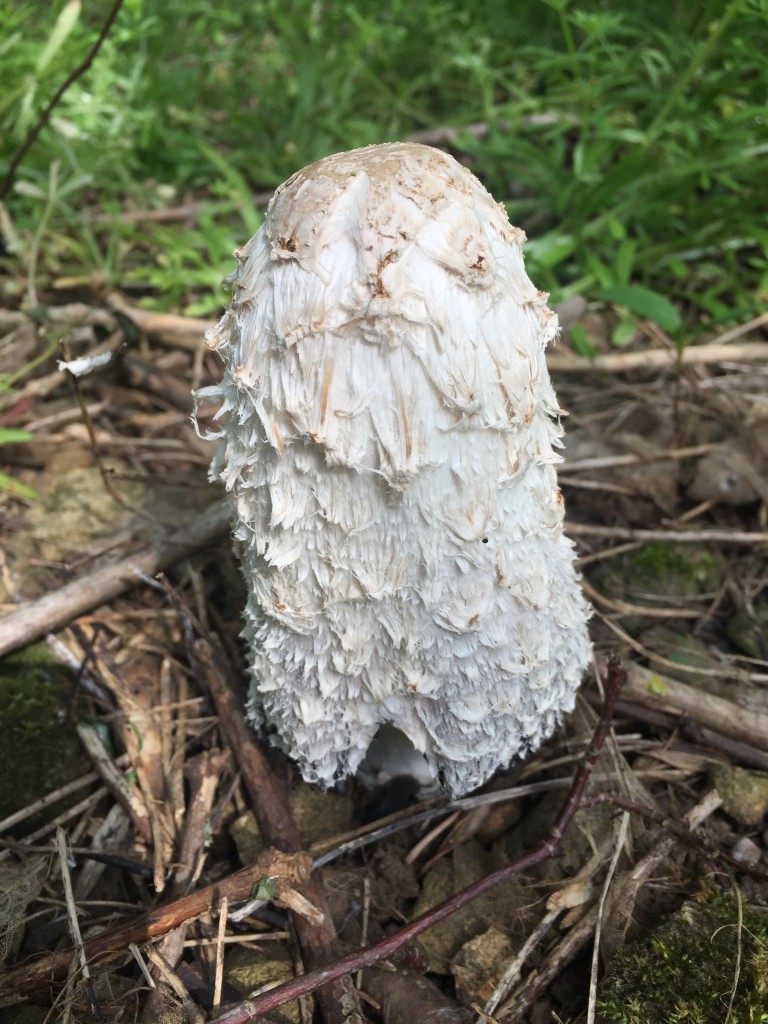
We have seen several examples of this distinctive and easily recognisable mushroom popping up amongst the leaf litter on the east side of Deer Park Wood. This one, seen in May 2019, shows the distinctive cylindrical white shaggy head covering the whole length of the stem forming large, curved, scales which flatten after exposure to rain. The head can be up to 150mm long and 60mm in diameter. The white cap will deliquesce, dissolve into a black liquid, within hours of depositing spores or being picked.
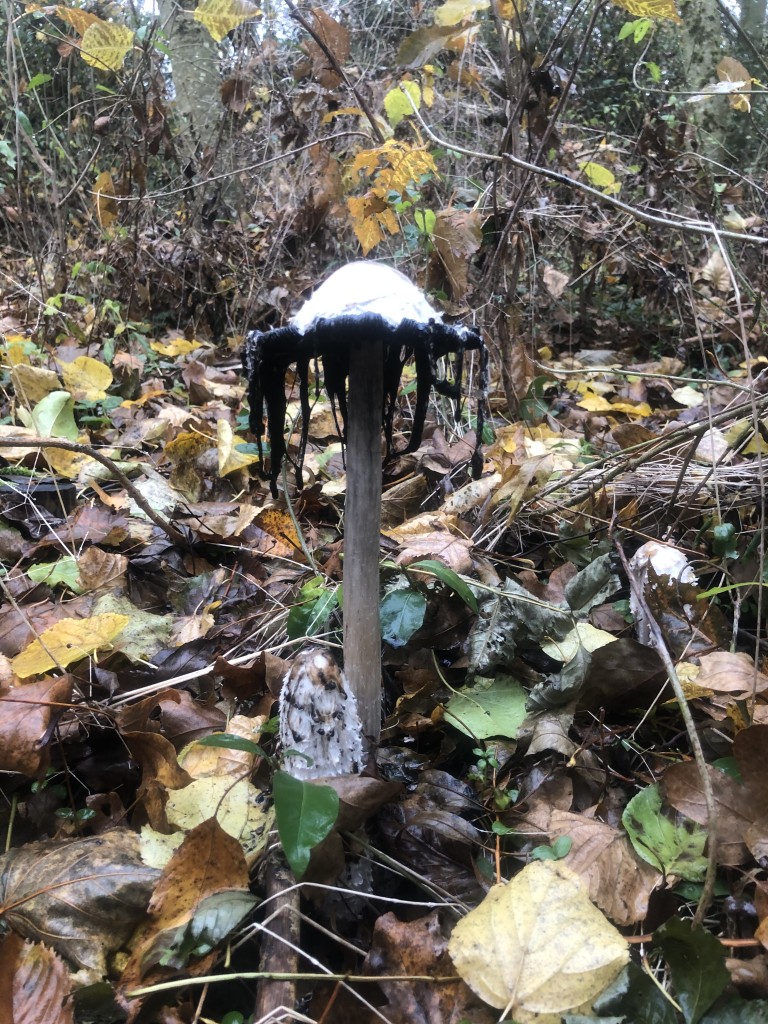
It is classed as edible, and if chopped and gently boiled forms a dark, richly-flavoured base for a soup or stew. (John Wright in his book Mushrooms does say it tastes of boiled polystyrene! – but opinions differ). It must be cooked soon after picking while still white or the cap will quickly start to dissolve into the black ink that gives this mushroom its common name.
Flammulina velutipes – Velvet shank
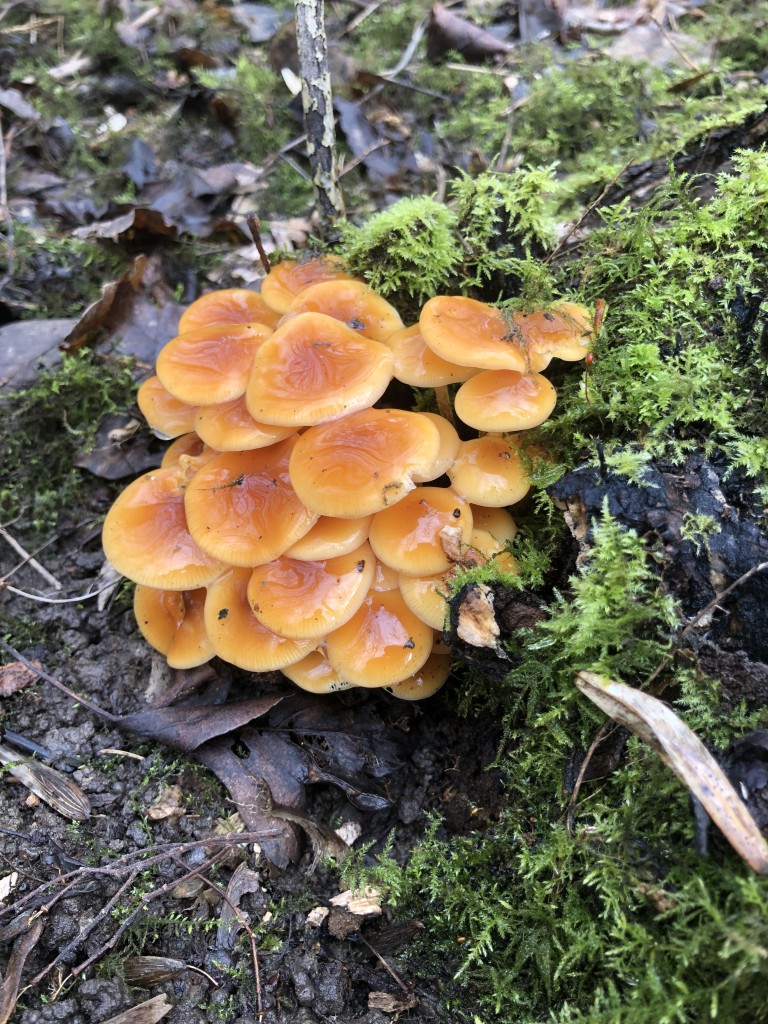
—
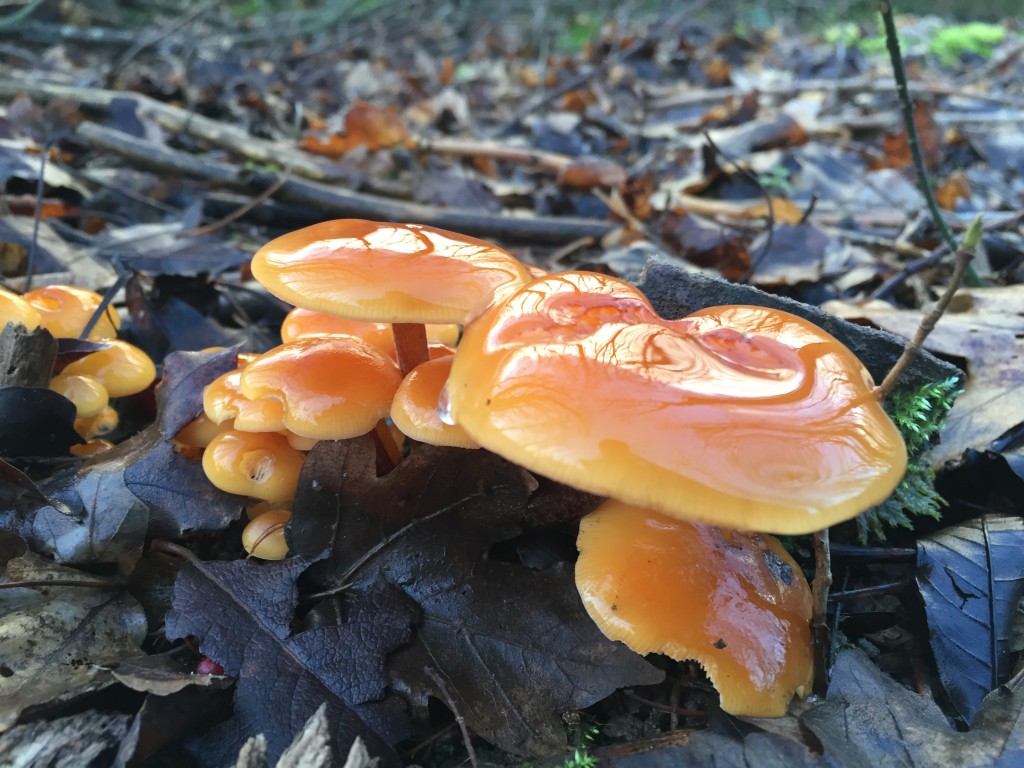
These glossy mushrooms with 20mm to 100mm wide orange/brown caps are usually found during winter growing on tree stumps or dead wood. They can be found covered in snow and apparently even survive being frozen solid. They used to be commonly found on elm prior to Dutch elm disease, now they appear on ash, beech, or oak. We have found them in DPW from December to March. The group on the left were spotted on an ash stump. Classed as edible but they must be cooked and are reported to have a nutty sweet flavour. According to Pat O’Reilly, extracts from this species show exceptionally high anti-cancer activity.
Sarcoscypha austriaca – Scarlet Elfcup
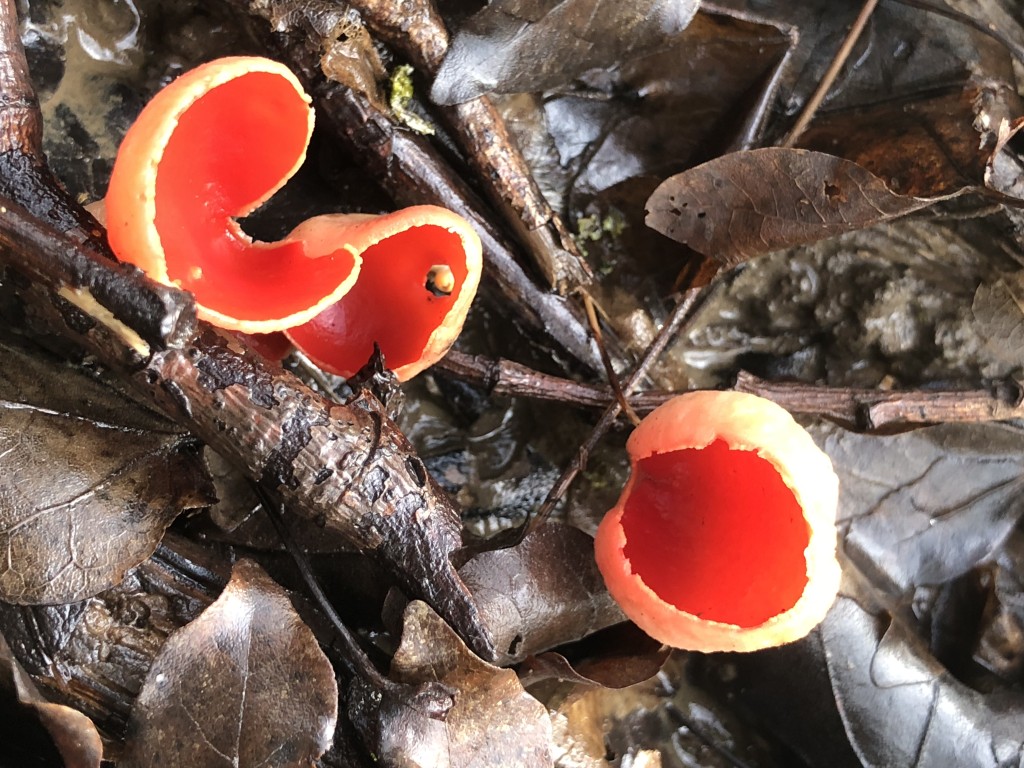
This beautiful fungus is described as inedible by the Woodland Trust, while other sources say that they are edible if they are thoroughly cooked, though lacking flavour – so why bother? Just enjoy the sight of them on the woodland floor. The cups are 10mm to 70mm in diameter and grow on fallen hardwood twigs and branches. Said to appear from spring through to the end of winter, we’ve found several in DPW in February. Some were in very wet areas of leaf litter, others on drier, higher ground. When present, their scarlet cups stand out like no other fungus, so they are very easy to spot. They are said to make a tiny puffing sound when they release their spores into the air. According to the Woodland Trust, Oneida Native Americans would place them under bandages to stop bleeding!
Crepidotus cesatii – Roundspored oysterling
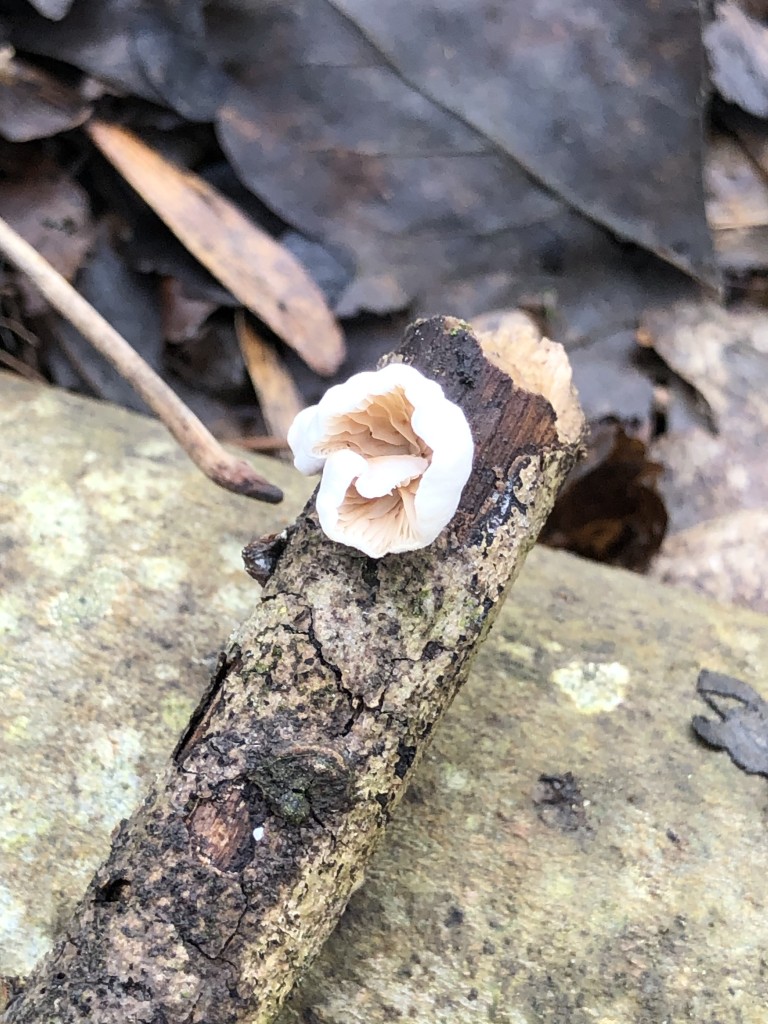
This tiny 5mm to 20mm shell shaped fungus has no stems: their gills start white and then turn pinkish/brown. Beautifully delicate in both form and colour, they are said to appear from August to December, but they have been found growing on dead wood as late as March in DPW. These are definitely to be enjoyed visually and not for eating.
Daldinia concentrica – King Alfred’s Cakes
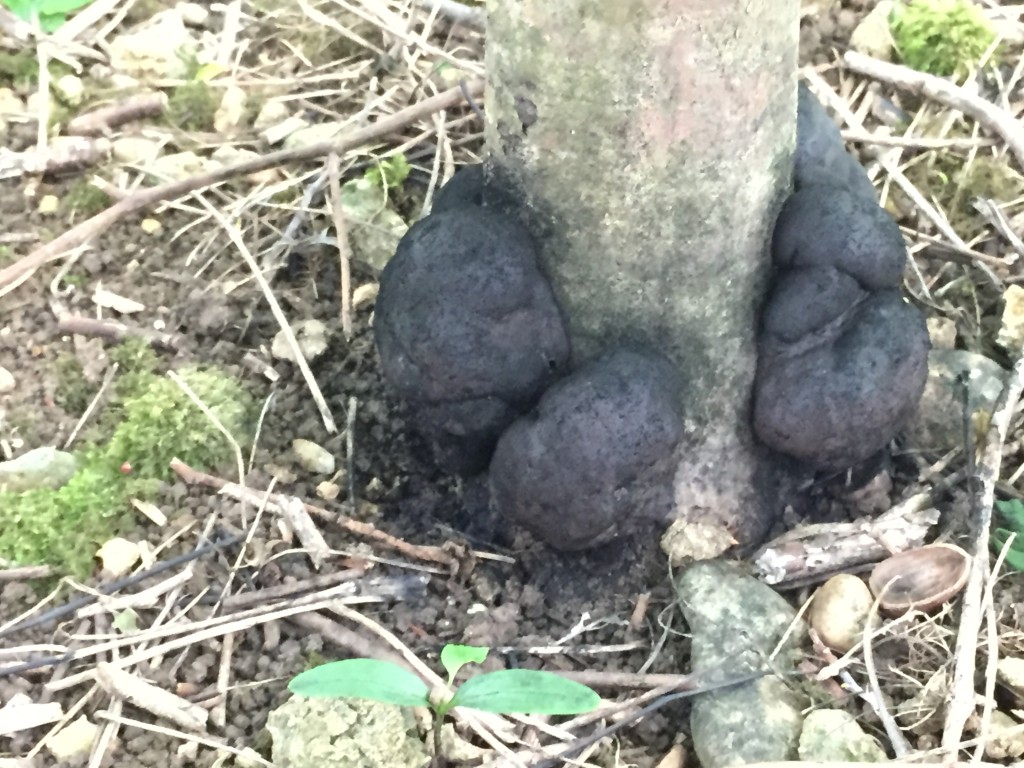
Most often growing on ash and beech wood throughout the year, there are records of this fungus being found during the excavation of a 7000-year-old Spanish settlement where they were thought to have been used to help light fires. In a recent TV programme, bushcraft expert Ray Mears demonstrated how to catch a spark from struck flint in a piece of this fungus which then smouldered gently, allowing fire to be transported to a new location. The black spores ejected from these fruiting bodies can be seen on the trunk on which each piece is growing. Measuring from 20mm to 100mm in diameter they can be used as charcoal briquettes to cook food while producing minimal smoke, a feature taught to special forces.
Auricularia auricular-judea – Jelly ears or Wood ears
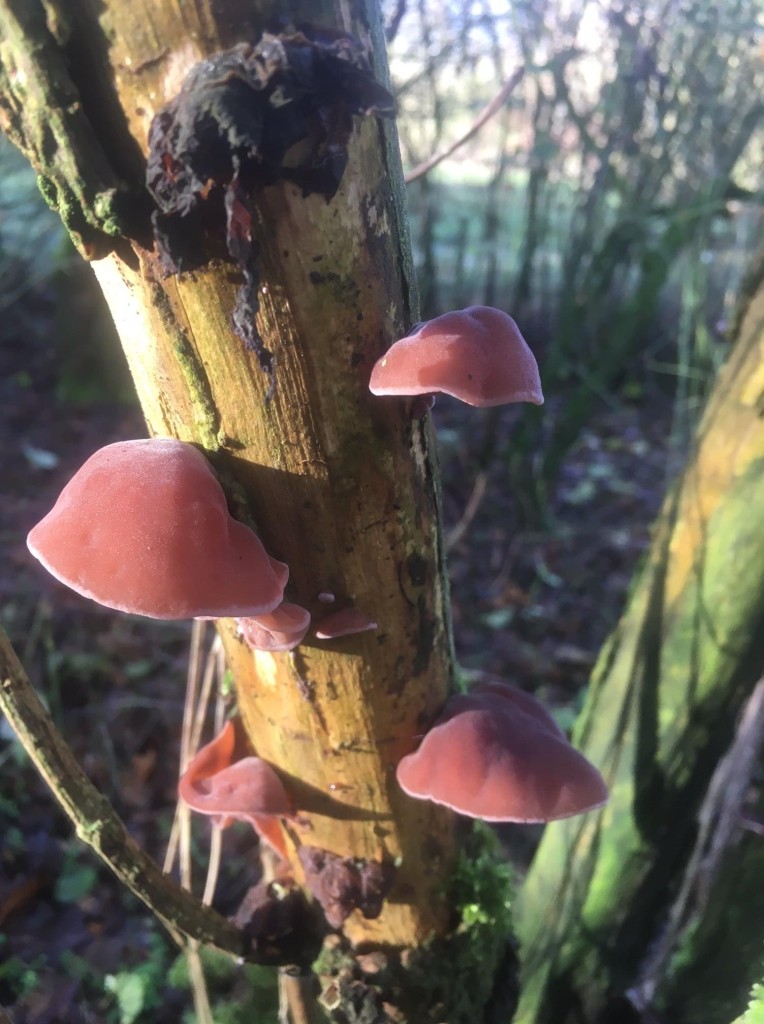
..
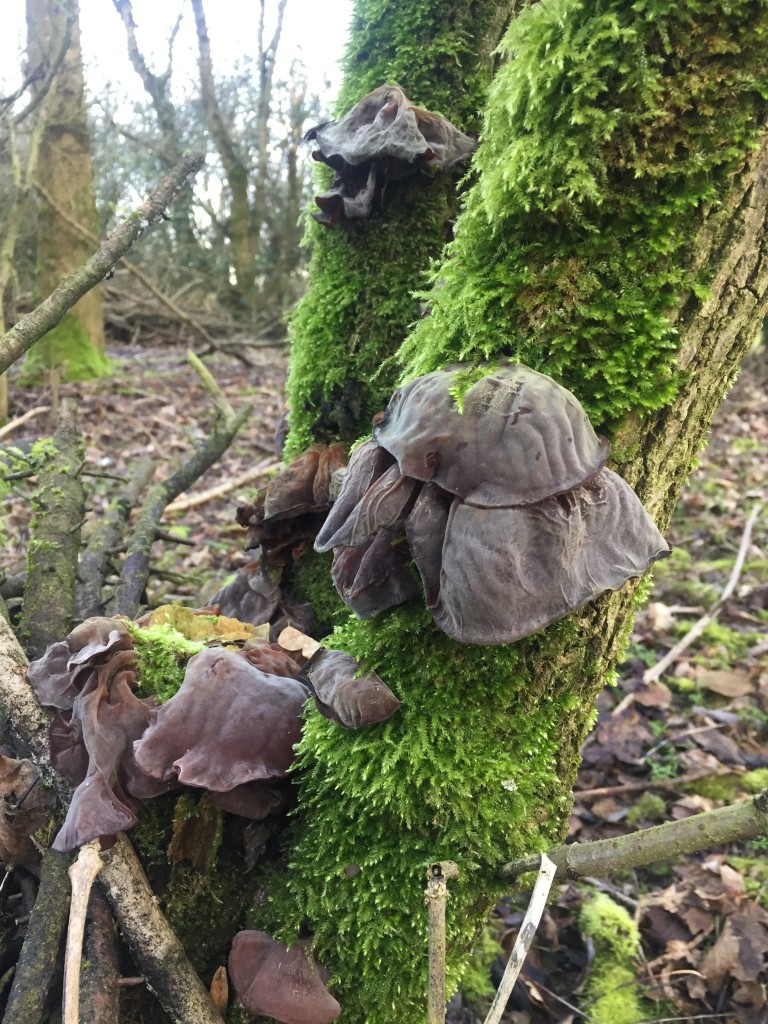
Found mainly on the dead branches of elder trees and liking damp or shady areas, this species can grow up to 100mm across. This example was first spotted growing at the southwest corner of DPW in December 2020. Their colour and appearance changes as they age as can be seen above. The lower picture, taken a month later, looks startlingly like Darth Vader peering out of the tree! Apparently almost half a million tonnes are cultivated annually for use in Chinese cuisine. They are common in DPW and mainly visible in winter and spring.
Trametes versicolour – Turkeytail
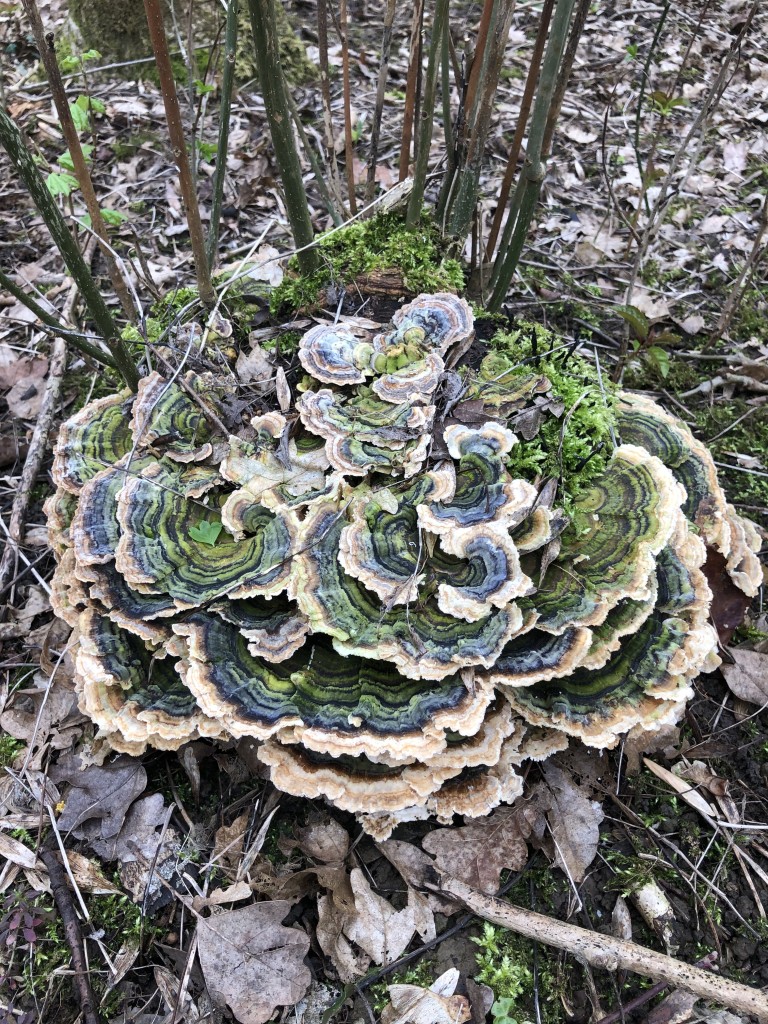
Turkeytail is a very common bracket fungus, found throughout the year across the UK, it appears in a variety of colours. They are at their best in autumn and winter when they release their spores. This beautiful blue example was growing on a felled ash stump in DPW. The individual caps can be up to 100mm in diameter and frequently overlap to form much larger fruiting bodies. Because of their attractive appearance, they have been used in the past as table decorations and to adorn hats. The upper surface displays concentric zones in a variety of colours, red, yellow, green, blue, brown, black and white. One of more than 100 species of medicinal mushrooms, these are used in Asian countries. According to the US National Library of Medicine, consumption of turkeytail mycelium, the fungal threads from which the fruit body grows, is known to enhance innate immune responses, the first line of defence against invading pathogens, and adaptive immune responses.
Daedaleopsis confragosa – Blushing bracket
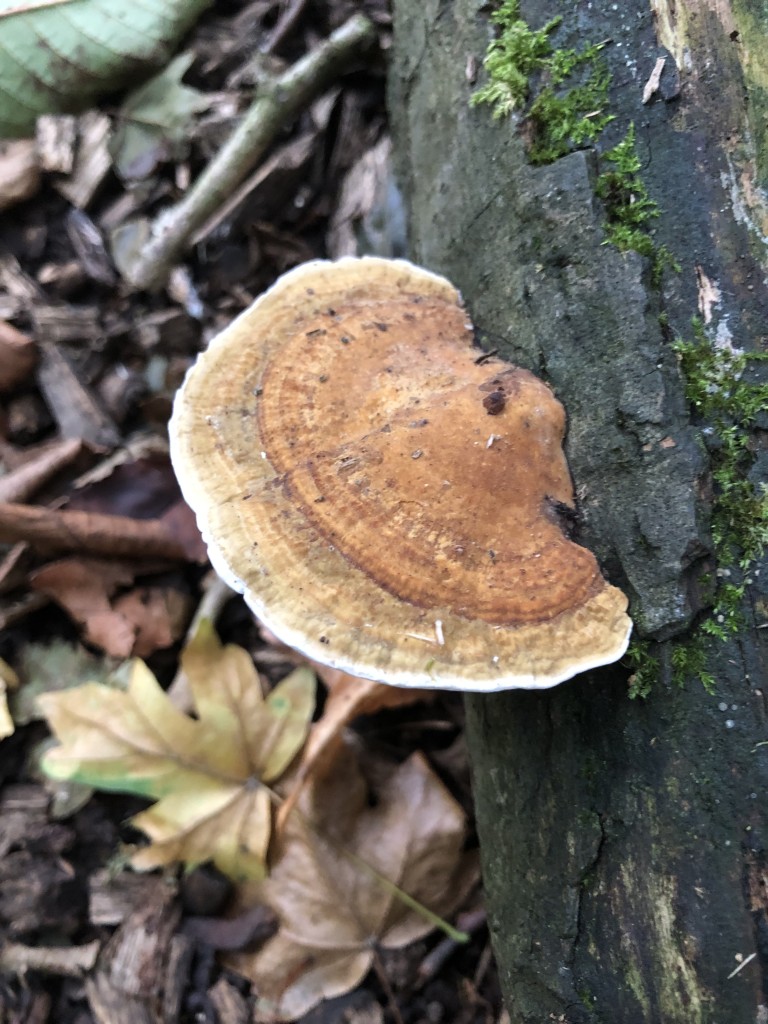
—
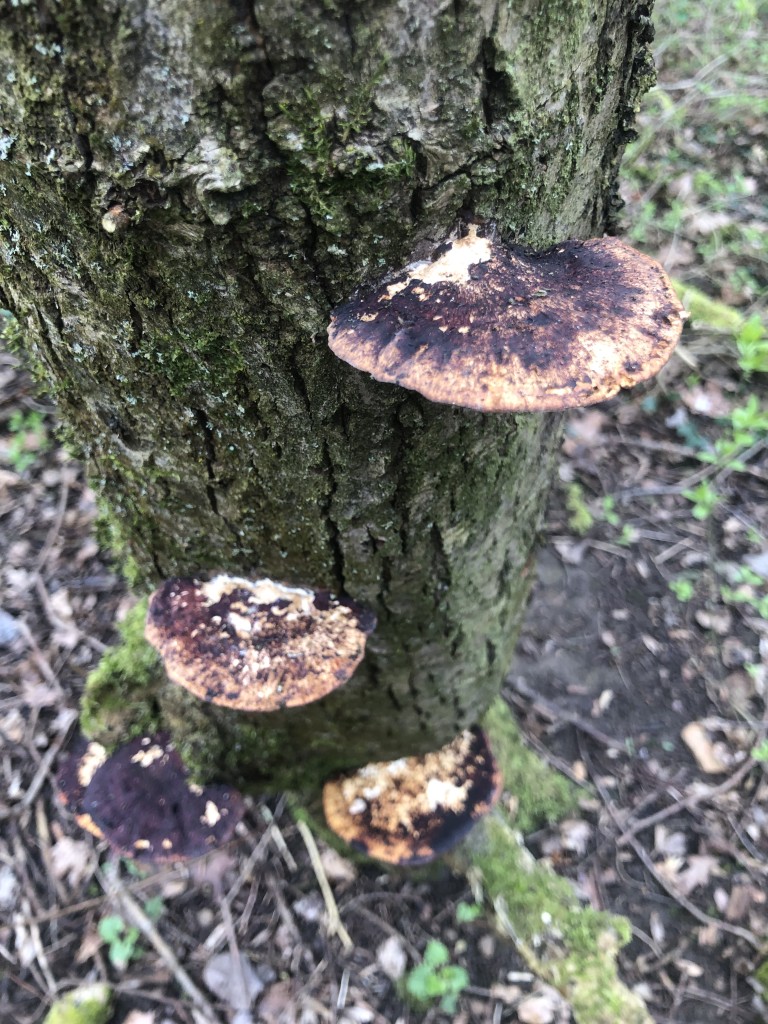
This common, medium sized fungus, oval in shape and up to 200mm x 100mm in size, is found on the dead wood of beech, birch and, most often, on dead or dying willow. It grows singularly or most commonly in tiers, often without the reddish warts. The lower, older, example was seen in March 2024 and the other in September 2024. Unlike the majority of other fungi, they can be found throughout the year and can continue growing for several years, they release spores in late summer and autumn.
Postia stiptica – Bitter bracket
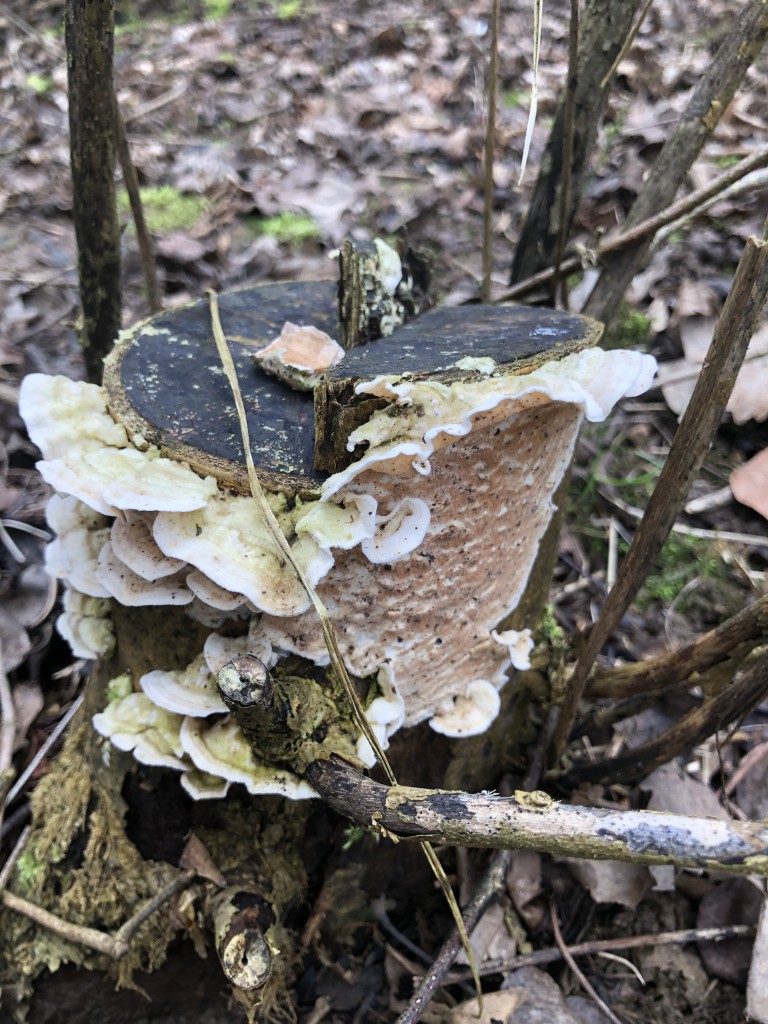
—
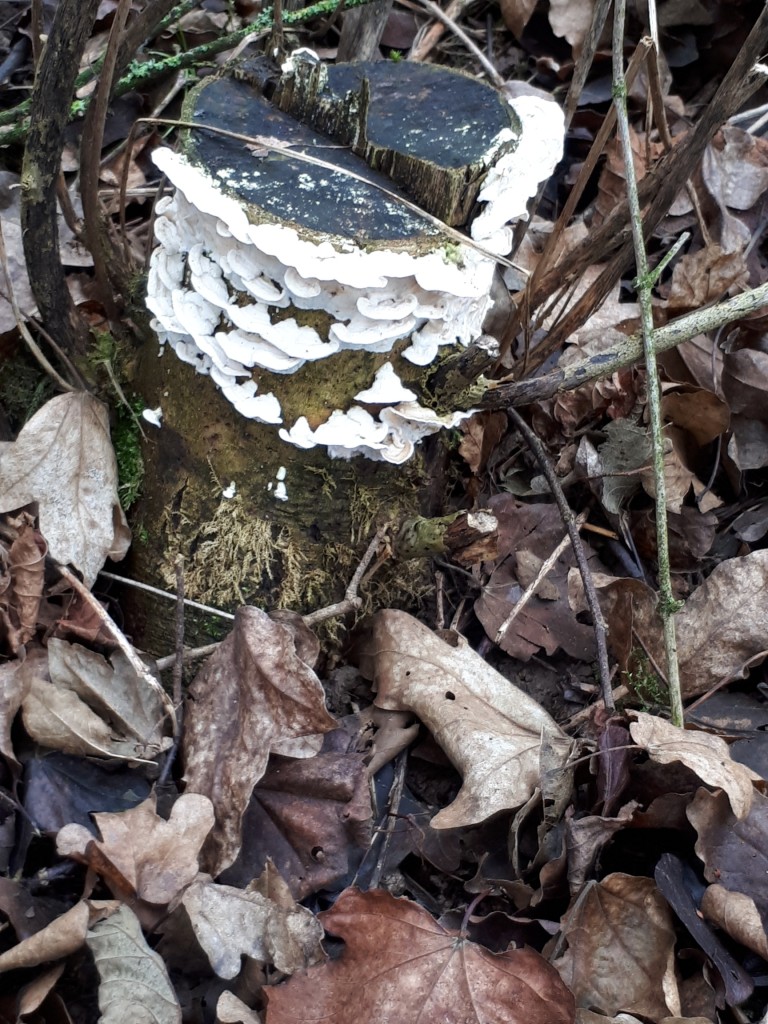
Fairly common, these brilliant white fruiting bodies can be found in tiers on the sawn ends of felled tree trunks as were these examples which were seen on ash stumps at the north end of DPW. They can grow up to 100mm. The Bitter bracket exudes water droplets from the edge and pores during all but the driest periods although this was not evident when these examples were photographed in March 2024.
Polyporus squamosus – Dryad’s Saddle
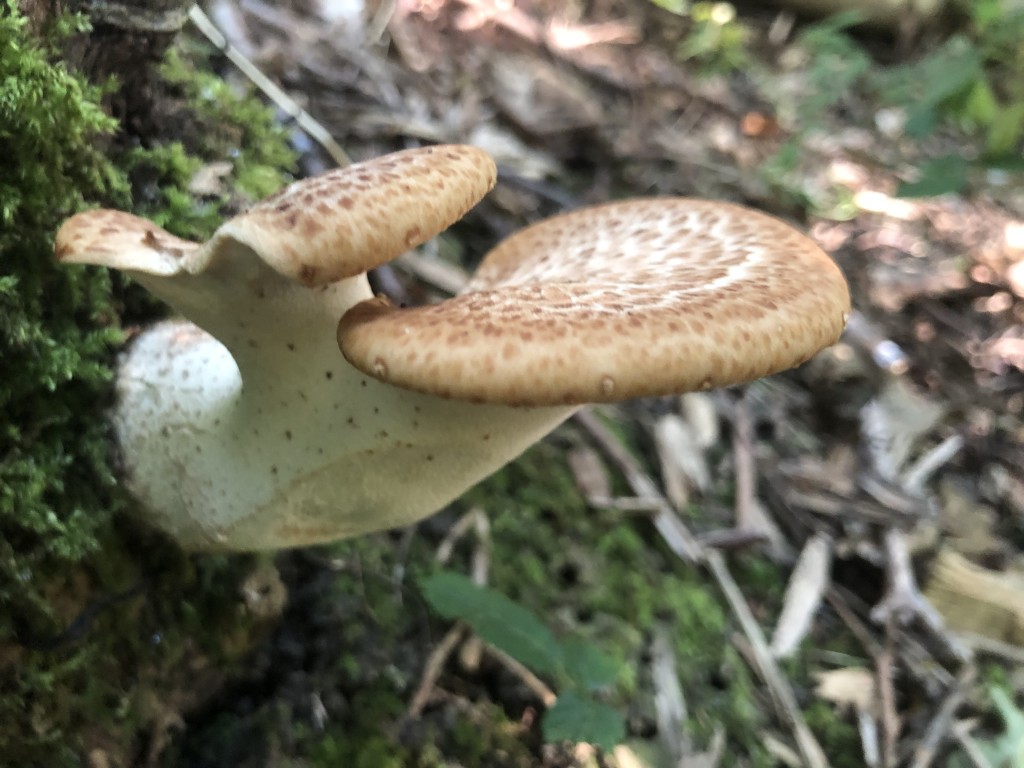
—
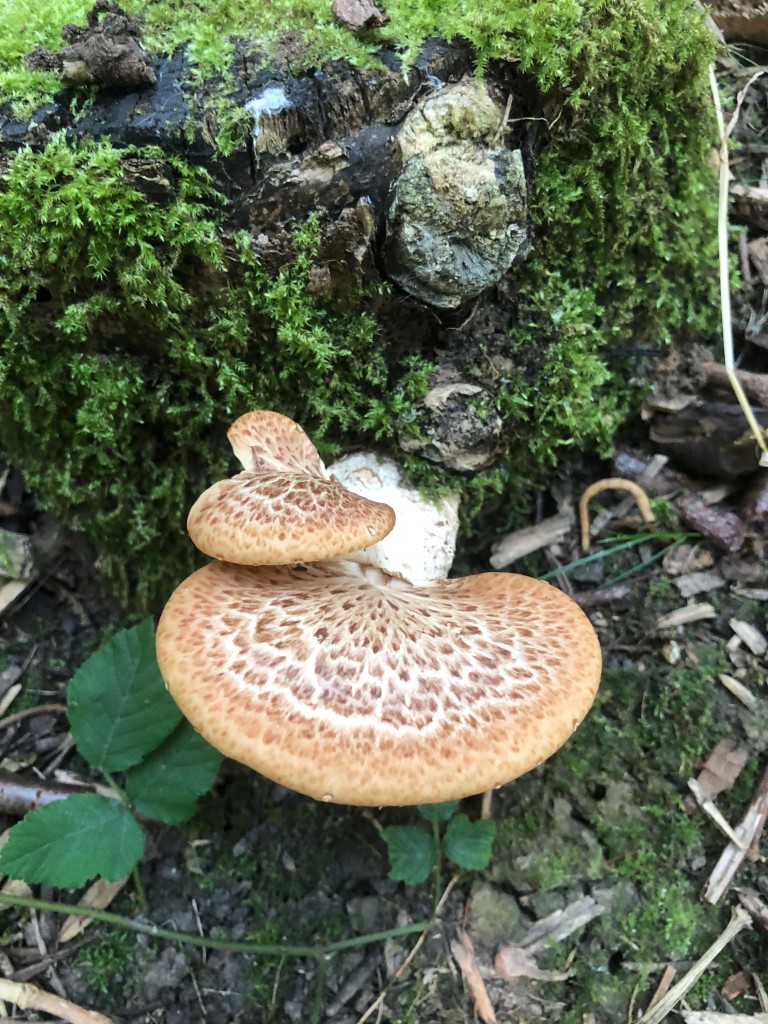
Another species of bracket fungus, Dryad‘s Saddle, is very common and parasitic on deciduous trees such as elm, beech and sycamore. The outer edges of young caps are said to be edible. The fruitbody can grow up to 500mm across and can appear on the same host tree for several years. It is the largest capped mushroom in the UK, growing in clusters that can weigh up to 4-5kg, if they have an adequate food source. Appearing in summer and autumn, this one was found on 31st July 2024, next to the east path in DPW growing on a tree stump. In warm weather they can decay in just a few days, as this example did.
Tubaria furfuracia – Scurfy Twiglet or Winter twiglet.
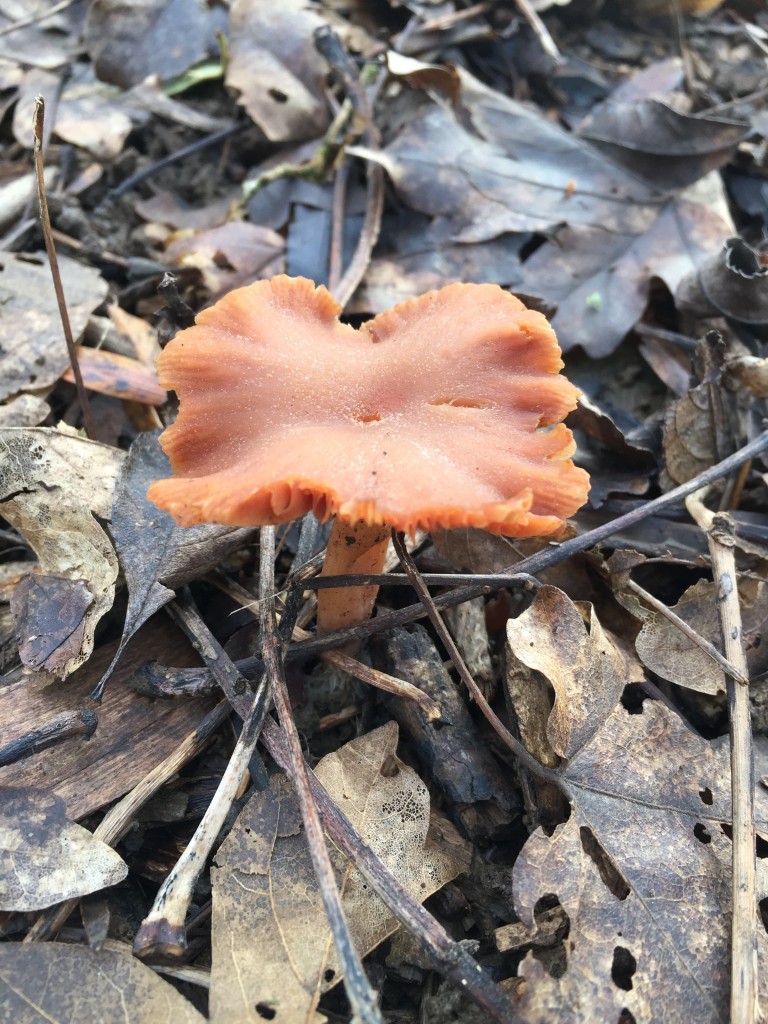
—
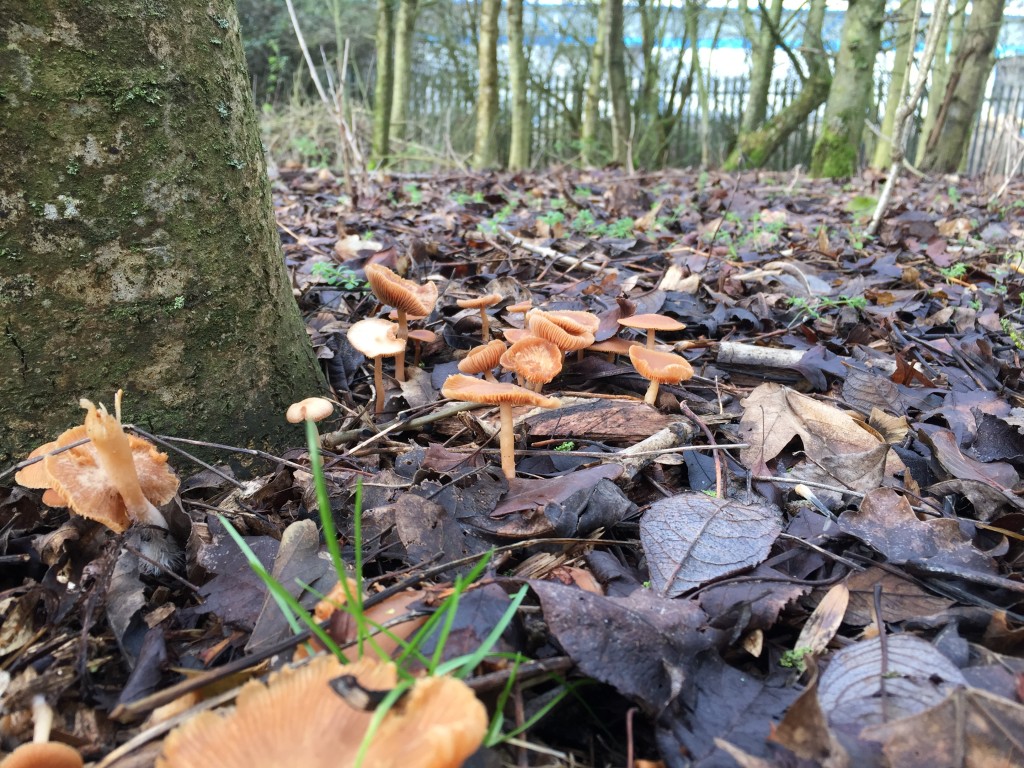
Common and widespread, these were seen in leaf litter on the west side of DPW on 2nd January 2021. Starting life with a convex cap of 10mm to 40mm diameter, this appears to become concave with age. Both forms can be seen above. The gills are the same colour as the cap. Very common, usually seen in autumn to early winter but can be present all year round.
Volvopluteus gloiocephalus – Stubble rosegill
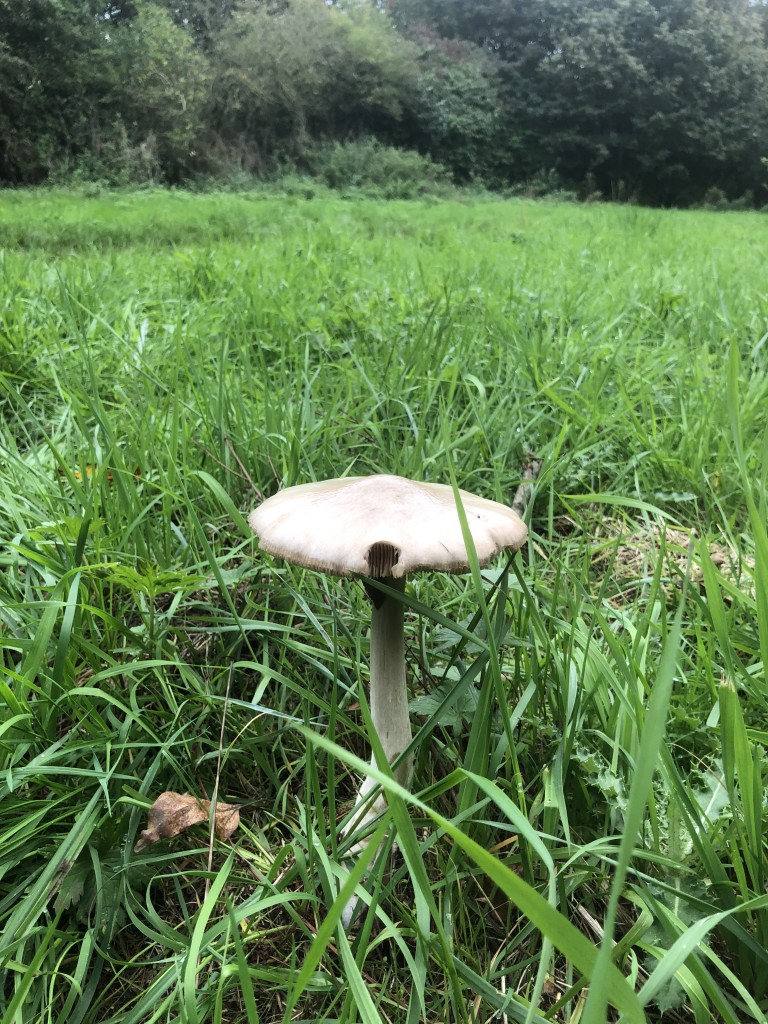
—
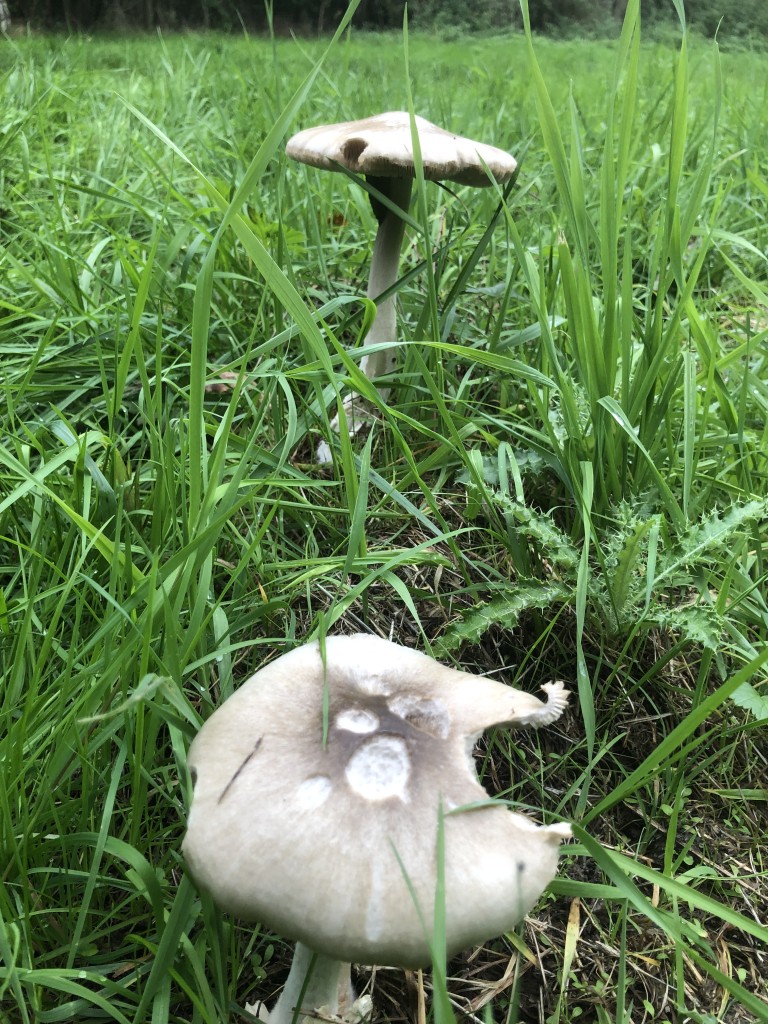
Found on roadside verges, permanent pasture and grassland, these appeared in the DPW central meadow in October 2023. Generally regarded as edible but they are easily confused with the deadly Death Cap and Destroying Angel. Ingestion of a Death Cap will result in death from kidney or liver failure, as no antidote exists.
Caprinellas micaseus – mica inkcap or glistening inkcap
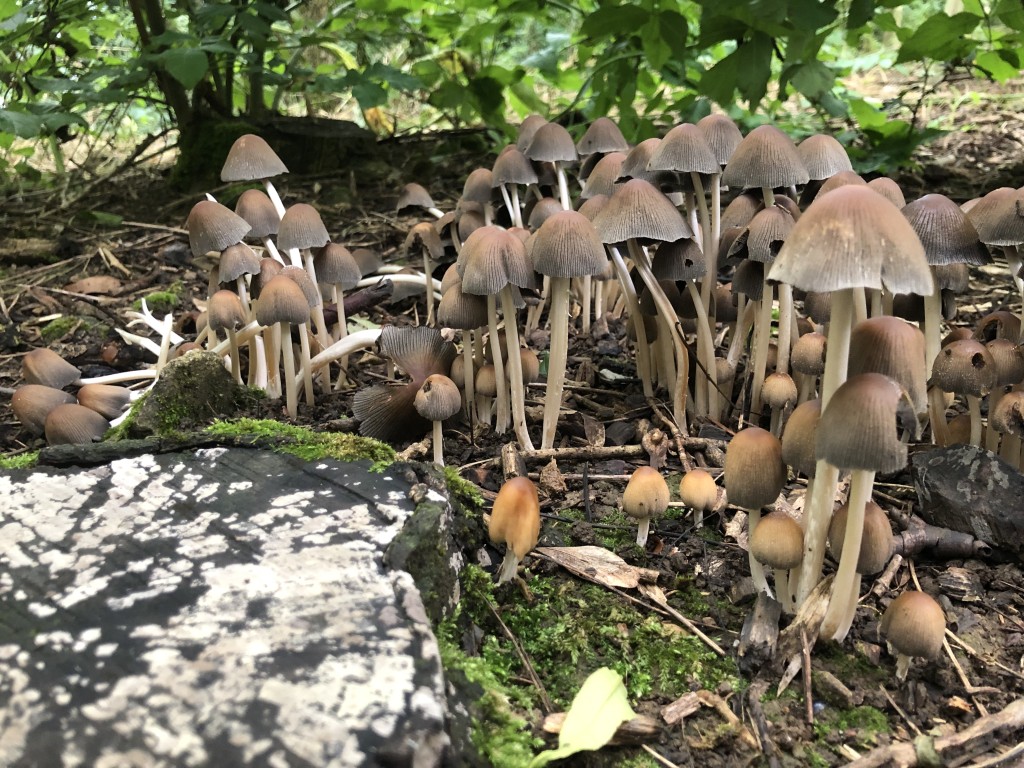
—
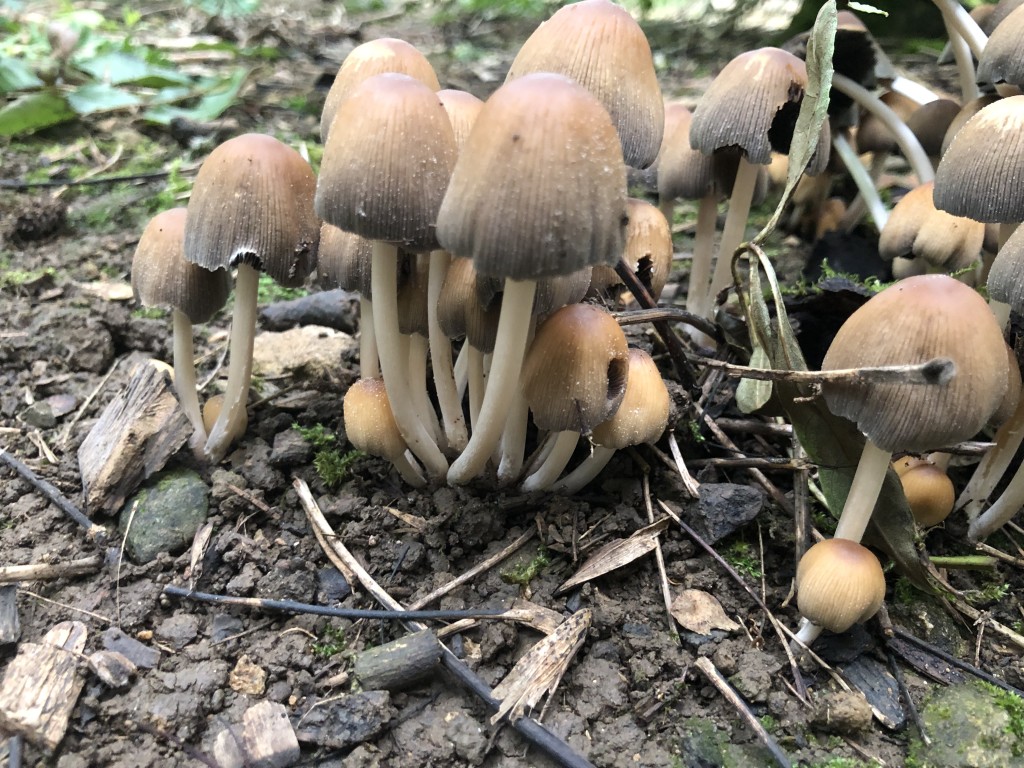
The mica or glistening inkcap usually appears in quite large clusters, growing on or besides tree stumps, as was this group seen next to the west path in DPW in July 2024. It appears from May to November and is classed as edible but not highly regarded. It can be potentially poisonous if collected from roadsides or polluted land where the mycelium can absorb heavy metals. The caps start life egg-shaped with tiny white glistening granules on the surface. As they mature the caps become bell-shaped and the gills change from white to black before deliquescing (decomposing into liquid) from the margin. The name ‘micaseus’ means similar to grains of salt, or mica. In the lower picture, the sprinkling of mica like grains can be seen.
Chondrostereum purpureum – Silverleaf fungus
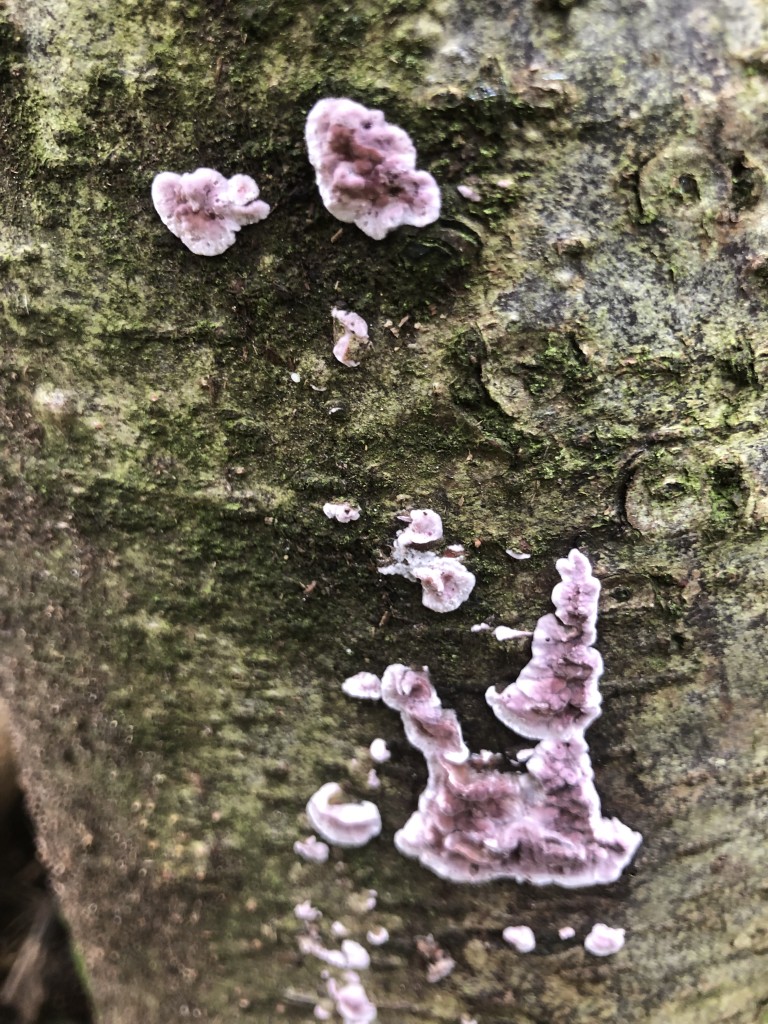

Photographed in DPW in 2014 and October 2024, this type of crust fungus causes Silver leaf disease in fruit trees if the airborne spores land on freshly exposed sapwood where damage has occurred. This particularly affects the genus Prunus, which includes cherries and plums. To avoid this, these trees should be pruned in summer when the problem spores are not around. Silver Leaf disease typically appears progressively on one branch which, if cut back, will display brown staining. The tree can be saved if the branch is cut back to a point where no staining is seen and a fungicide is applied to the cut face. Silvering of leaves across the whole tree though is unlikely to be Silver Leaf disease and more likely to be the result of heavy pruning. Chondrostereum purpureum nutrient paste was approved for commercial use in 2001 in Canada to remove forest ‘weed trees’ – unwanted species – in commercial forests.
Stropharia caerulea – Blue roundhead
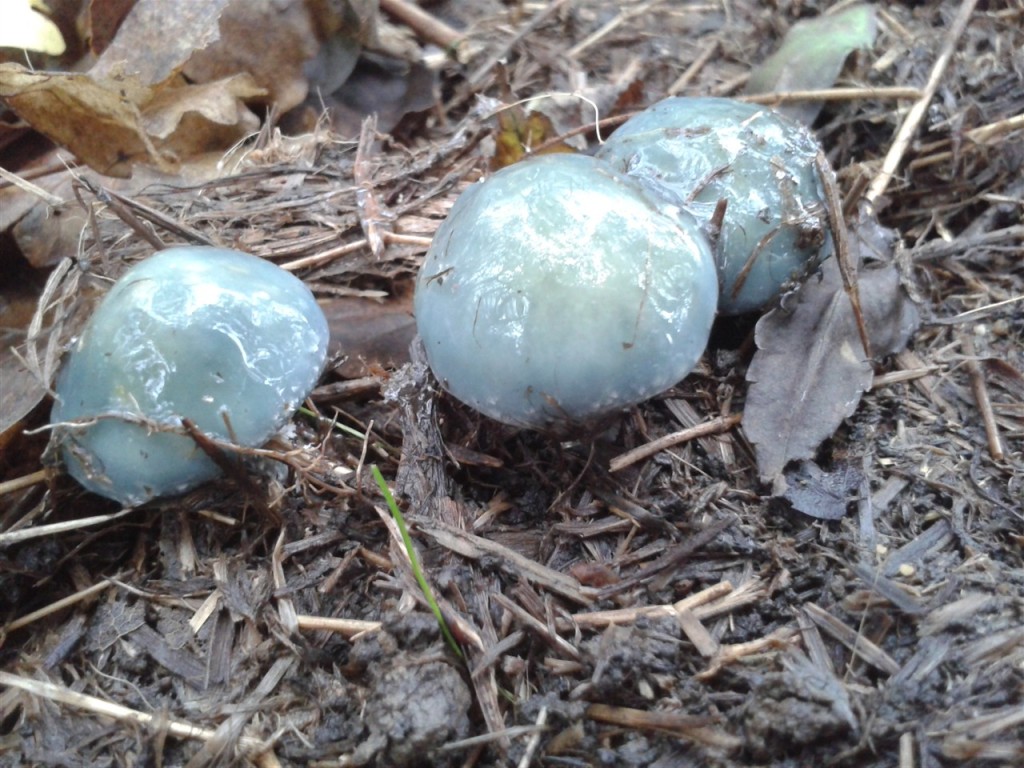
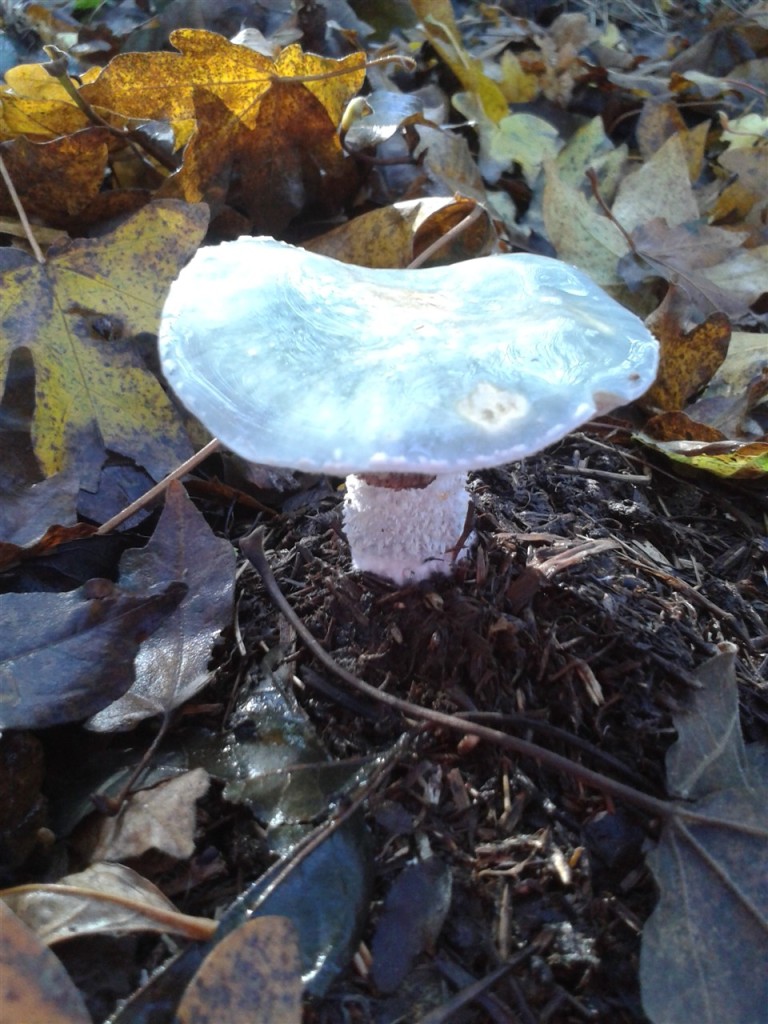
Another species from 2014. Pat O’Reilly, in his book ‘Fascinated by Fungi’, describes this as ‘One of the few blue-green fungi. In most instances the slimy caps are much nearer to green than blue, but when young and fresh they are very beautiful and startling. The caps, initially bell-shaped, flatten and turn paler from the centre. White scales near the cap rim help to identify this unusual fungus.’ They are found in grass and leaf litter in late summer to autumn. The stem has a persistent ring, covered in pointed white scales, which can be seen in the lower photo.
Crepidotus variabilis – Variable oysterling
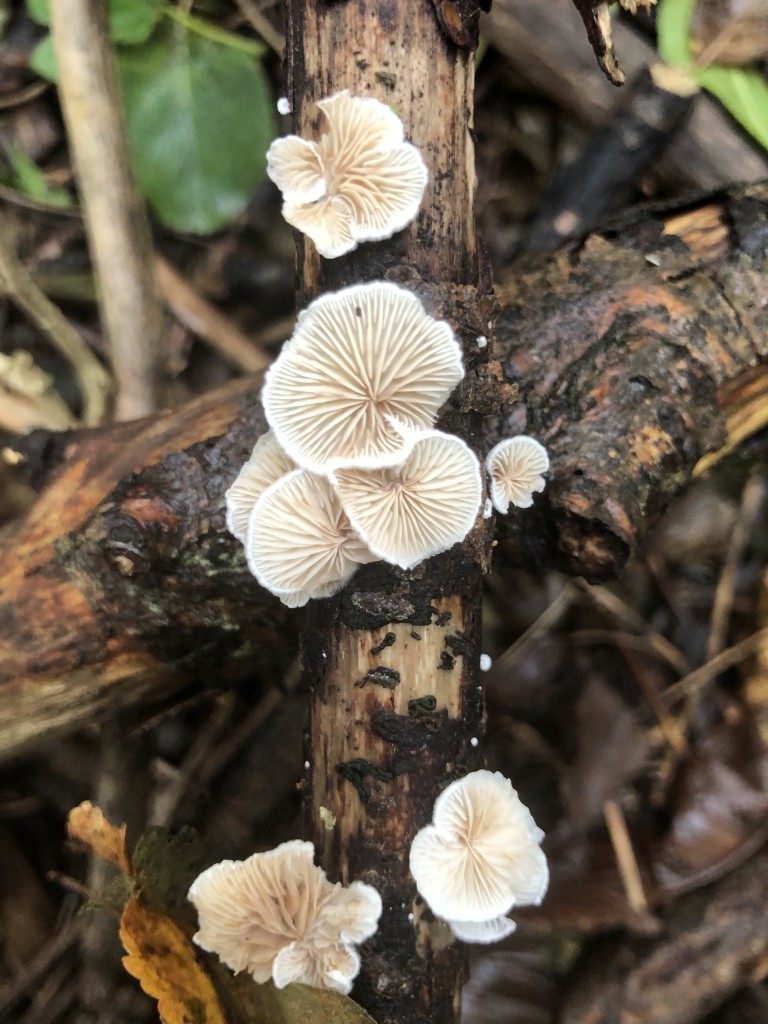
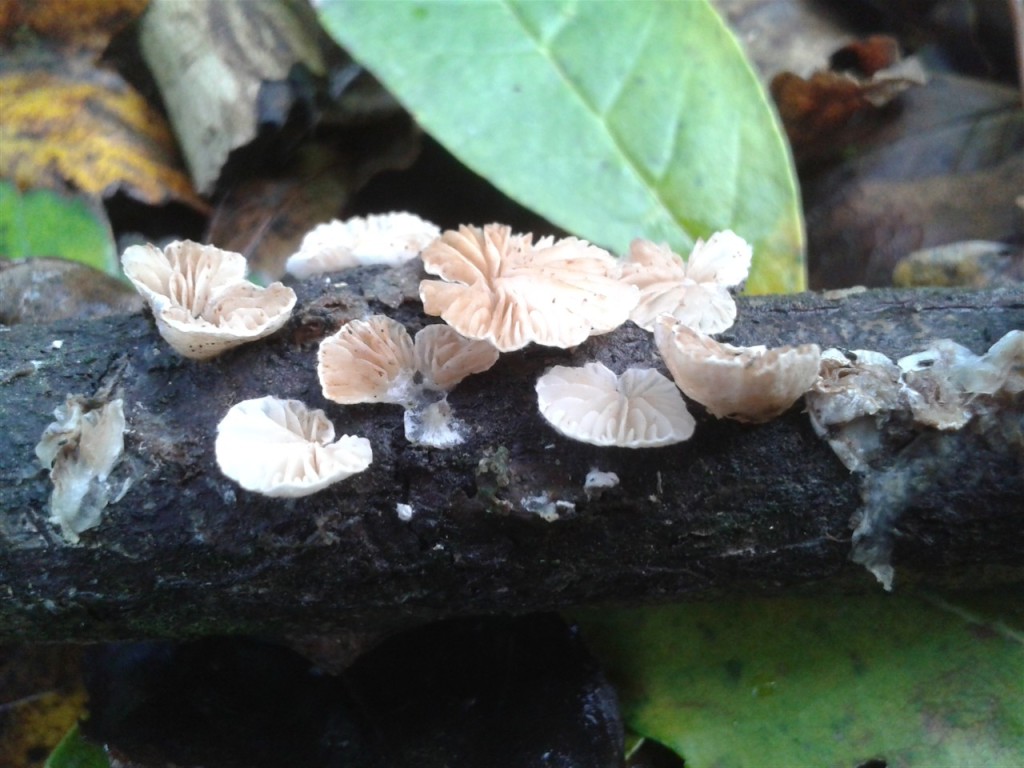
Very similar to the Roundspored oysterling in size and appearance, except the gills of the Variable oysterling are white at first, turning buff. This species has no stem: the 5mm to 30mm kidney-shaped caps form on the fallen twigs of rotting hardwood trees, often overlapping as in this example. They can be found from August to December. According to First Nature website, some authorities include the genus Crepidotus within the family Inocybaceae and some Inocybe species are deadly poisonous, so don’t be tempted to sample these, just enjoy their delicate form.
Xylaria hypoxylon – Candlesnuff fungus or Stag’s horn


Stag’s Horn is the more descriptive name for this small but common fungus which was found on a stump next to a log marking the east path in DPW on 14th October 2024. The fruit bodies are quite small, 20 to 60mm tall and 1mm to 4mm wide. It appears on the rotting stumps of broadleaf trees throughout the year, turning black once it has produced spores in autumn and early winter. According to Pat O’Reilly, it consumes the polysaccharides, compounds of timber that bind the cellulose and lignin together, leaving a nutrient-rich, soft mess that insects and other small creatures are able to feed on. Bioluminescent, as phosphorous within the mycelium reacts with oxygen, but emitting a very weak light needing an image intensifier to detect, so don’t expect to see a spooky light show marking your path if you venture into DPW at night! There are several examples on stumps next to the paths, peering out of lovely green moss.
Hydnellum peckii – Bleeding tooth, Devil’s tooth or Strawberries and cream
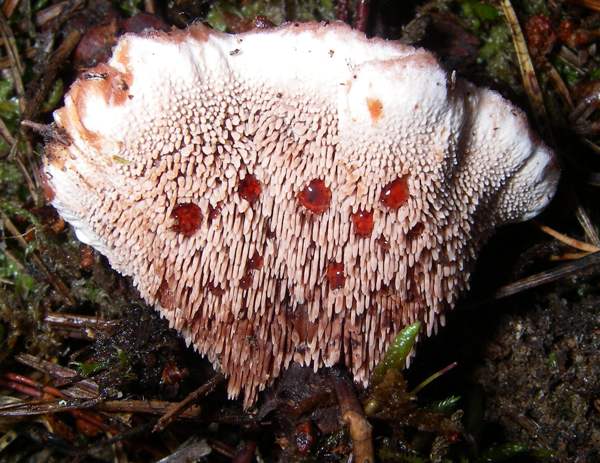
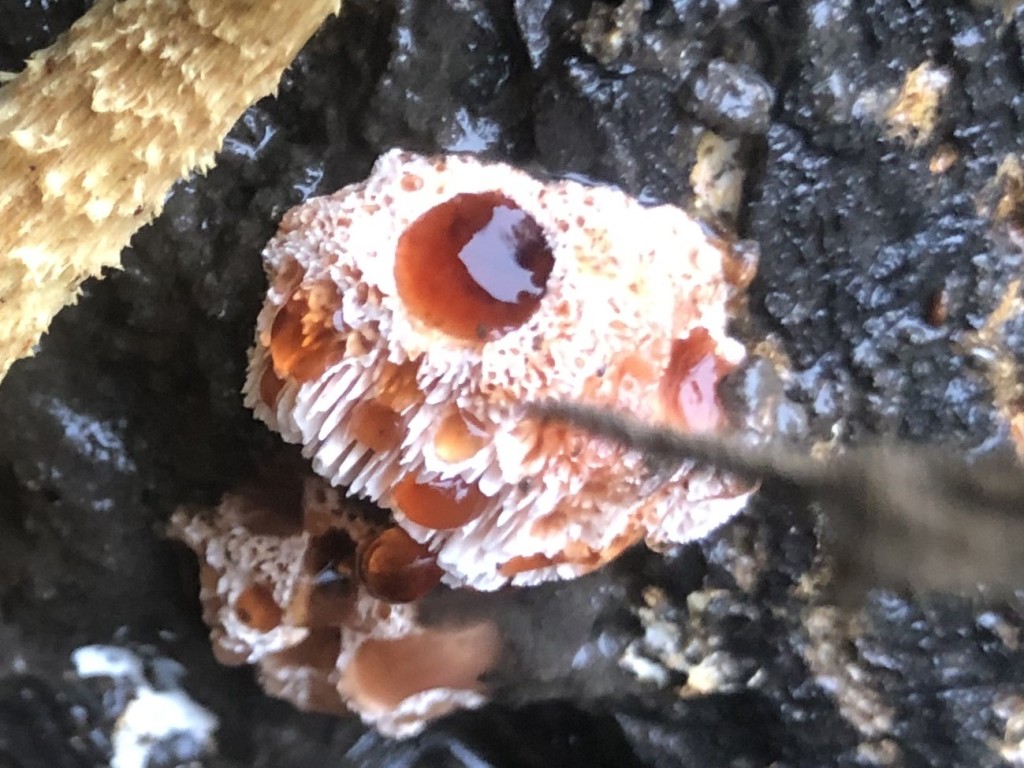

This startlingly beautiful fungus, almost looking like a cupcake in this picture, was one of several found on the underside of a log next to the very wet section of the east path in DPW on 14th October 2024. This 20mm wide young cap is exuding red droplets, apparently a type of sap, which forms when the soil surrounding the fungal mycelium becomes very wet. This is absorbed by the mycelium by osmosis and then out through the fruiting bodies. It appears red due to a pigment found in the fungus. The pinkish spines are 1mm to 5mm long.
According to Pat O’Reilly, this species is rarely found in Britain except in Scotland – so putting into doubt this identification. All official records of this species on the Fungal Records Database of Britain and Ireland are from Scotland. It occurs in coniferous woodland, which we don’t have in DPW, but it was found amongst woodchips we’d laid on the path last year, delivered by an unknown donor. We have had a high proportion of conifer leaves in previous donations, so they could be coniferous chippings, although obviously not from Scotland.
As a comparison, the picture at the top appears in Pat O’Reilly’s website First Nature, the spines and red droplets look very like our example. Contains the chemical compound atromentin, which has anti-coagulant, and anti-bacterial properties.
————————————————————————————————-
The next instalment of the fungi notes is here